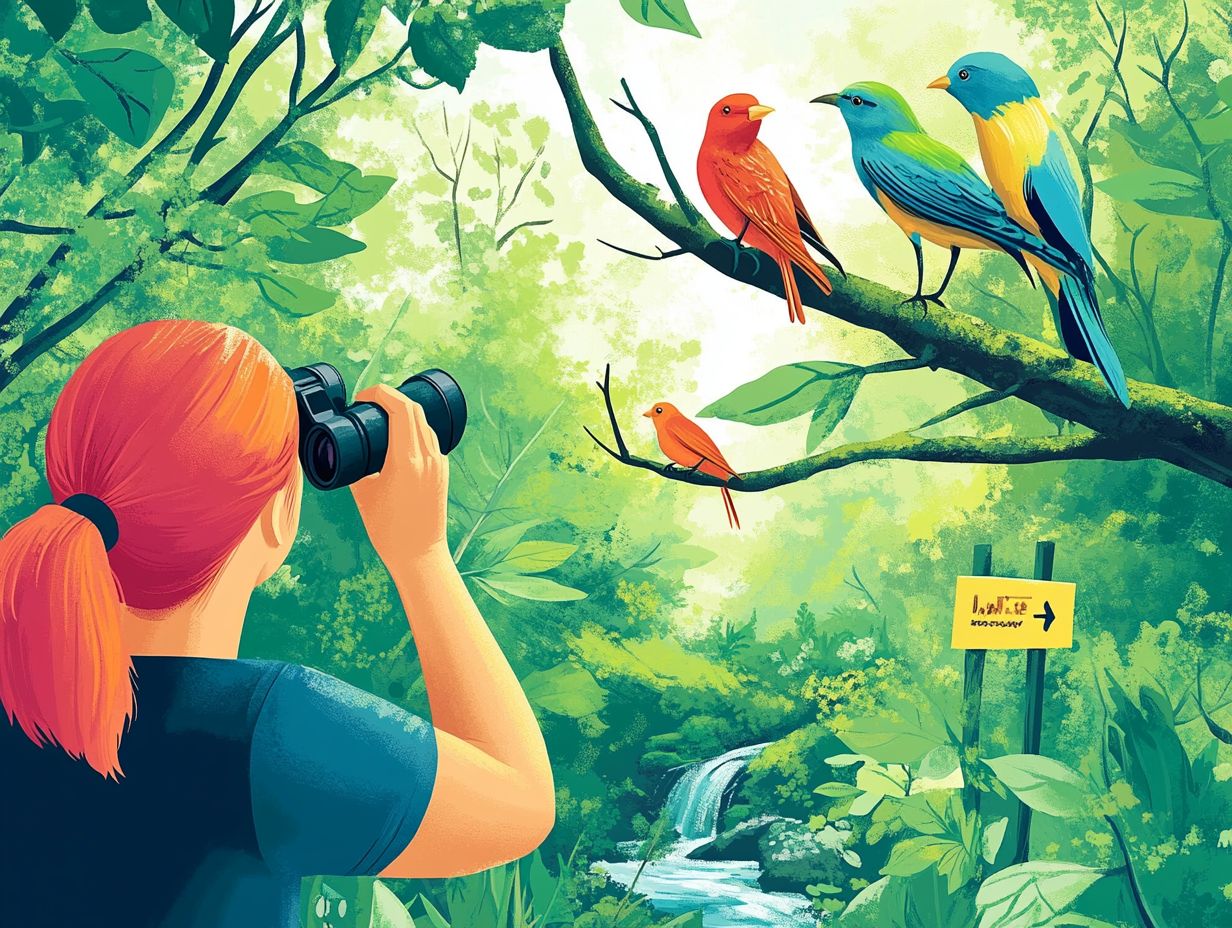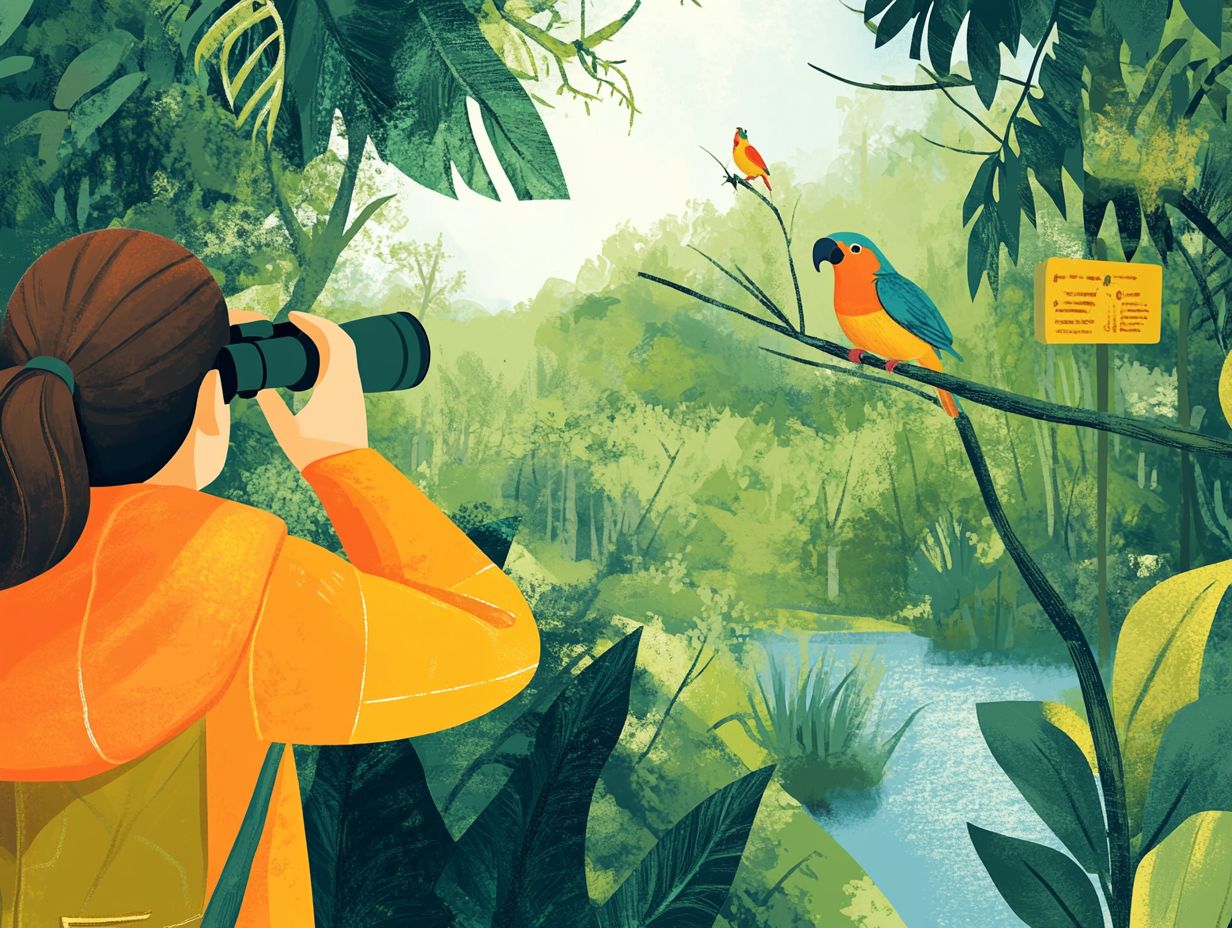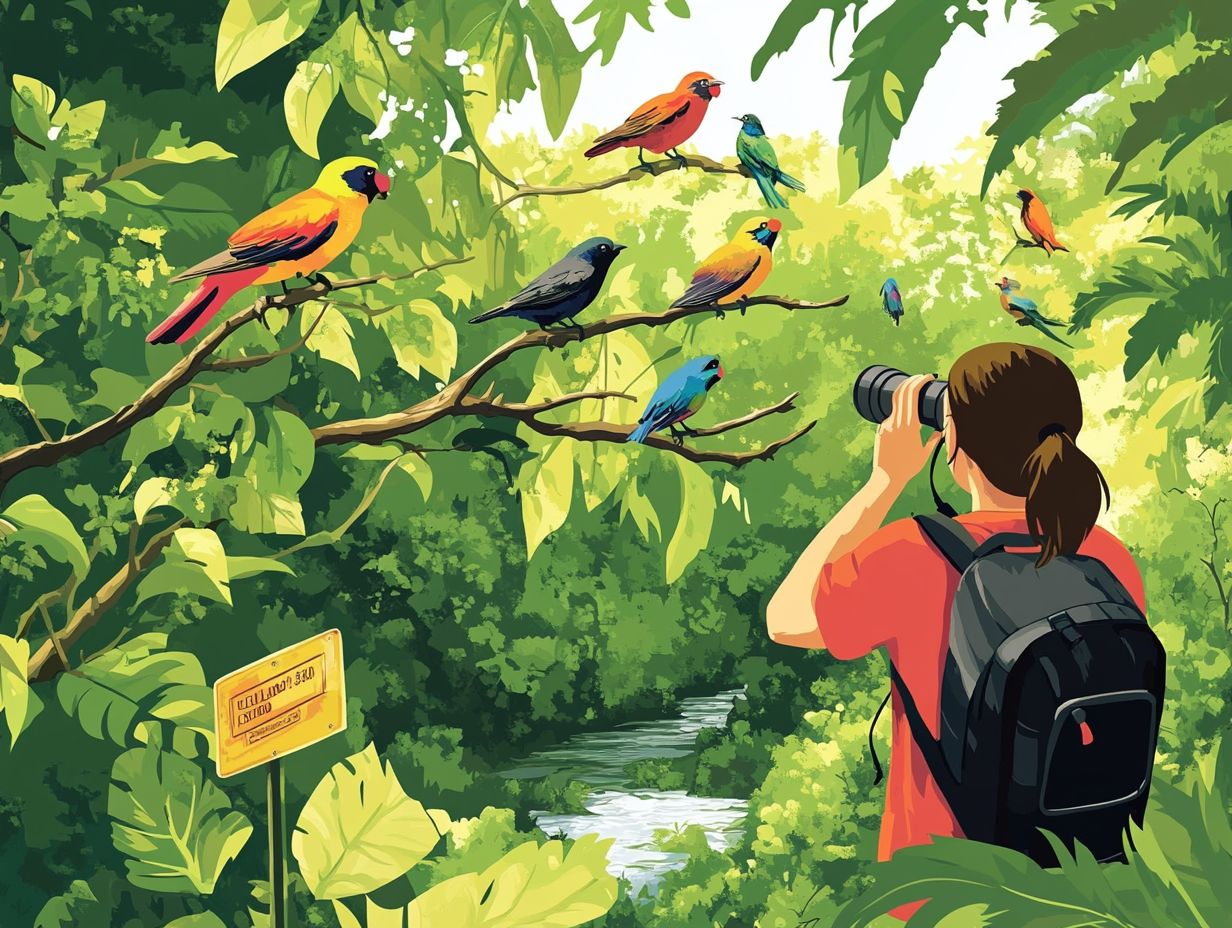Eco-Friendly Birdwatching: Best Locations to Visit
Birdwatching goes beyond just a hobby. It s a fantastic way to connect with nature and support conservation efforts.
You will also discover exciting ways to help ongoing conservation initiatives and receive invaluable tips for minimizing your environmental footprint. Embark on this journey to uncover how birdwatching can be not only a delightful experience but also a meaningful contribution to the well-being of our planet.
Contents
- Key Takeaways:
- 1. Top Eco-Friendly Birdwatching Locations in North America
- 2. Best Eco-Friendly Birdwatching Spots in Europe
- 3. Eco-Friendly Birdwatching Destinations in Asia
- 4. Conservation Efforts in Eco-Friendly Birdwatching Locations
- 5. Tips for Sustainable Birdwatching
- 6. The Future of Eco-Friendly Birdwatching
- Frequently Asked Questions
Key Takeaways:

- Explore top eco-friendly birdwatching spots in North America, Europe, and Asia to see diverse bird species and help wildlife conservation.
- Follow simple tips to minimize your environmental impact while birdwatching.
- Support conservation efforts to protect these special places and enjoy the benefits they offer.
1. Top Eco-Friendly Birdwatching Locations in North America
North America has some of the best eco-friendly birdwatching spots. These places attract bird lovers keen to see a variety of species and unique habitats.
Locations like Everglades National Park and backyard birding offer exciting opportunities for sightings. For those looking for eco-conscious adventures, check out eco-friendly camping: top spots. Responsible practices help keep these experiences sustainable for future generations.
Among the standout practices, responsible feeding and habitat restoration are vital for supporting migratory species, helping them thrive on their seasonal journeys. Take Estero Llano Grande State Park, for instance; it s celebrated for its restoration efforts and offers birders the chance to spot vibrant species like the Green Jay and the Great Kiskadee.
Central Park in New York City is a crucial stopover for migratory birds. You can marvel at the majestic warblers during spring migration. These hotspots not only act as sanctuaries but also enhance local biodiversity, creating unforgettable birdwatching experiences and deepening your appreciation for the avian world.
What Makes These Locations Eco-Friendly?
Eco-friendly birdwatching locations have unique characteristics that promote sustainable practices and protect avian habitats. Through conservation initiatives and responsible tourism, these practices benefit both wildlife and birdwatchers, enriching your wildlife observation experiences.
In these areas, habitat restoration projects play a key role in rejuvenating ecosystems. They provide safe nesting grounds and essential food sources for various bird populations. The presence of eco-friendly facilities, designed to minimize environmental impact, encourages you to engage with nature responsibly.
Community engagement initiatives enhance your experience, creating local partnerships centered around environmental education and stewardship. As you immerse yourself in these thoughtfully curated environments, you not only contribute to conservation efforts but also deepen your connection with the diverse species that inhabit these vibrant landscapes.
How to Get to These Locations?
Reaching eco-friendly birdwatching locations can be both accessible and enjoyable. You ll find a variety of transportation options that elevate your birdwatching experience.
Whether you choose to travel by car, public transport, or embark on guided tours, convenient routes are available to popular birding hotspots and nature reserves.
Opting for public transport not only keeps your budget in check but also helps reduce your carbon footprint. This makes it a favored choice among nature enthusiasts like you.
Bus and train systems frequently provide direct access to some of the most breathtaking habitats. This allows you to immerse yourself in nature right from the start.
If you prefer more flexibility, renting a vehicle is an excellent option, particularly for exploring remote areas where public transport might not reach.
Guided tours offer invaluable insights from experts and the chance to connect with like-minded individuals, all while minimizing your environmental impact.
To further champion sustainability, pack biodegradable supplies and practice Leave No Trace principles during your travels. Leave No Trace is a set of guidelines for minimizing human impact on nature. This way, you can help ensure that these stunning locations remain preserved for future visitors.
2. Best Eco-Friendly Birdwatching Spots in Europe
You ll find many eco-friendly birdwatching spots in Europe that showcase a rich tapestry of bird species and unique habitats. These places are appreciated by both birdwatchers and conservationists.
Imagine standing amidst the breathtaking landscapes of the Rietvlei Nature Reserve or exploring the renowned Ottenby Bird Observatory. These locations serve as sanctuaries for migratory species and havens for birding enthusiasts alike.
Committing to sustainable practices not only elevates your birdwatching experience but also deepens your connection to the environment.
These carefully protected spaces highlight the vital importance of conservation efforts. They ensure that small ecosystems thrive and provide essential support for migratory bird populations.
Observatories and reserves regularly host birdwatching tours and events that attract passionate birders while educating the public about the significance of these natural habitats.
As a participant, you can engage with local experts who share invaluable insights into the migratory patterns and nesting behaviors of various species.
Such community-oriented initiatives raise awareness about ecological challenges and foster a strong sense of stewardship for these treasured landscapes.
What Makes These Spots Eco-Friendly?
The eco-friendly spots in Europe stand out for their unwavering commitment to bird conservation and sustainable practices. They craft environments that nurture a rich variety of plants and animals.
Here, conservation efforts seamlessly blend into your visitor experience, allowing you to relish wildlife observation while minimizing your ecological footprint.
By participating in habitat protection initiatives, you contribute to the preservation of native flora and fauna, ensuring that birds have safe nesting grounds.
Community involvement is often a vital component, with local residents actively maintaining and safeguarding these natural areas.
Many of these destinations are equipped with eco-friendly facilities, such as solar-powered observation towers and biodegradable amenities. These enhance your experience without detracting from the natural beauty that surrounds you.
This holistic approach fosters responsible tourism and enables you to connect more profoundly with the ecosystems you cherish.
Don t miss your chance to witness these incredible habitats!
How to Access These Spots?

Accessing Europe s finest eco-friendly birdwatching spots is easy, thanks to a variety of travel options tailored to your preferences and budget. Whether you seek the thrill of guided birdwatching tours or prefer the independence of public transport, there s something for every bird enthusiast eager to explore these remarkable locations.
If public transit is your style, trains and buses frequently connect to major birding areas. This allows you to effortlessly reach remote habitats teeming with avian life. Researching local schedules and ticket options can uncover significant savings while minimizing your carbon footprint.
As you plan your routes, think about incorporating bike rentals or walking paths. Not only do they enhance your experience, but they also help keep the natural surroundings undisturbed.
For a truly sustainable journey, choose accommodations that prioritize green practices, such as eco-lodges or campsites committed to wildlife conservation. Ensuring that all aspects of your travel align with sustainable principles will enrich your birding adventure. Consider exploring the best eco-friendly hiking destinations as this also helps safeguard these precious habitats for future generations.
3. Eco-Friendly Birdwatching Destinations in Asia
Asia offers a treasure trove of eco-friendly birdwatching destinations that beckon both novice and seasoned birdwatchers alike. Here, you ll find unmatched opportunities to observe a stunning array of bird habitats and species in their natural environments.
Places like the Changaram Wetlands and Pipeline Road serve as sanctuaries for a multitude of birds, including migratory species that rely on these rich ecosystems. The focus on sustainable practices in these areas ensures the protection of local wildlife while enhancing your birding experience. This is especially important if you’re passionate about conservation.
You can join guided tours that raise awareness about bird conservation techniques! These tours encourage you to maintain a respectful distance and rely on binoculars or spotting scopes instead of intruding on nests.
In these vibrant regions, you might encounter captivating species like the Malabar Grey Hornbill or the elusive Blue-throated Barbet. Both species flourish in the lush environments nurtured by eco-friendly initiatives.
By engaging in citizen science projects, you have the chance to contribute valuable data that helps track bird populations and migration patterns of these amazing avian visitors. Such immersive experiences deepen your connection to nature and cultivate a broader understanding of the vital importance of preserving these ecosystems.
What Makes These Destinations Eco-Friendly?
The eco-friendly birdwatching destinations in Asia truly shine with their sustainable tourism practices and strong dedication to conservation. Here, the focus is on preserving bird habitats and protecting species diversity. By embracing eco-friendly initiatives, these locations strive to balance tourism and wildlife conservation.
Local communities actively participate in habitat restoration projects, often engaging in efforts to plant native tree species and create inviting environments for birds. Educational programs empower you to understand the significance of conservation. They also encourage adherence to guidelines that minimize your impact.
This community-led approach deepens the connection between locals and their natural surroundings. It instills a sense of responsibility in tourists, transforming your experience into something not just enjoyable but profoundly enriching.
As a result, you can relish the breathtaking avian diversity these regions offer while positively contributing to the ecosystem. Join the movement to protect these vibrant ecosystems today!
How to Reach These Destinations?
Reaching eco-friendly birdwatching destinations in Asia is convenient and rewarding. You have various transportation options that prioritize sustainability.
By utilizing local buses or trains, you support the community and reduce your carbon footprint. This allows more resources to go toward preserving these rich ecosystems.
If you re seeking a more personalized experience, renting a bicycle can be a delightful way to explore the area. This combines physical activity with greater opportunities for wildlife observation.
Planning your routes with a focus on green travel options can lead you to hidden gems often missed by conventional tours. Carrying a reusable water bottle and minimizing plastic waste can boost the sustainability of your adventure, ensuring these breathtaking locales remain pristine for generations.
4. Conservation Efforts in Eco-Friendly Birdwatching Locations
Conservation efforts in eco-friendly birdwatching locations are vital for maintaining bird population stability and enhancing the diversity of bird habitats. They actively involve the birding community in sustainable practices.
These initiatives protect endangered bird species and spark excitement about bird migration patterns. They highlight why preserving our natural ecosystems is crucial.
By participating in these conservation efforts, you play a crucial role in ensuring future generations can also enjoy the rich avian diversity found in these essential habitats.
Join community-driven programs that invite local residents to engage in projects to restore natural areas, like planting native trees and removing invasive species. Educational workshops for schools and local groups provide excellent hands-on learning opportunities about avian ecology.
As a birdwatcher, you can make a meaningful contribution by volunteering your time, donating necessary supplies, or attending birding events that promote local conservation efforts. This engagement bolsters these programs and deepens your appreciation for the natural world.
What Are the Conservation Efforts in These Locations?
The conservation efforts at eco-friendly birdwatching locations focus on various initiatives designed to protect bird populations and their habitats. They emphasize sustainable practices that benefit both wildlife and visitors like you.
Success stories emerge from these locations, highlighting how reforestation initiatives have revitalized ecosystems and led to a remarkable increase in songbird populations. Community-based conservation programs invite local residents to actively participate in monitoring and protecting vital habitats, yielding benefits for both the environment and local economies.
As these birds flourish, your opportunities as a birdwatcher expand. You can observe rare species and join guided tours that educate you about the crucial role these efforts play in sustaining biodiversity. Engaging with these initiatives enhances your birdwatching experience and deepens your connection with nature.
How Can Birdwatchers Support These Efforts?

As a birdwatcher, you can play a vital role in supporting conservation efforts by actively engaging in local initiatives and contributing to the protection of bird habitats. By volunteering with conservation organizations, making donations, or advocating for sustainable practices, you can help ensure these essential ecosystems remain healthy and vibrant.
Joining local birding clubs allows you to contribute directly to habitat restoration projects and raise awareness about the significance of preserving natural spaces. Participating in community clean-up efforts can also make a difference.
Utilizing social media platforms to share your experiences and educate others can inspire more individuals to get involved, creating a ripple effect of conservation-minded enthusiasts.
Practicing responsible birding by adhering to ethical guidelines such as staying on trails and not disturbing nests is crucial for protecting bird populations. This builds a sense of responsibility among birdwatchers and encourages the community to protect our natural environment.
5. Tips for Sustainable Birdwatching
Embracing sustainable birdwatching practices is essential for you as a bird enthusiast who wants to preserve the variety of birds while creating unforgettable birding moments. By following specific guidelines and techniques, you can minimize your impact on the environment and ensure that bird habitats remain intact for future generations.
Simple actions such as using birdwatching apps to identify species, respecting wildlife observation limits, and selecting eco-friendly birding resources can significantly enhance your experience while promoting conservation efforts. For those looking to explore more, consider discovering green travel options like the best nature reserves.
It s crucial for you to stay mindful of your surroundings, maintaining a respectful distance from nests and feeding areas. This protects the birds and reduces stress on these sensitive creatures.
Engaging in ethical birding behavior, like avoiding loud noises and leaving no trace, fosters a harmonious relationship with nature. Utilizing technology, such as smartphone apps, can help you identify bird calls and behaviors without disturbing the wildlife.
Adopting these responsible practices will deepen your appreciation for nature and help protect it!
How Can Birdwatchers Minimize Their Impact on the Environment?
You can take several meaningful steps to minimize your impact on the environment while ensuring your birdwatching adventures are both eco-friendly and sustainable. By practicing responsible birdwatching techniques like observing from a distance and avoiding disturbances to wildlife you can indulge in your passion while safeguarding bird habitats.
This involves adhering to established ethical birding guidelines, which encourage you to stay on designated trails and refrain from approaching nests or feeding birds. This allows natural behaviors to unfold undisturbed. Being mindful of noise levels is crucial; excessive sound can startle birds and disrupt their routines.
Choosing environmentally-friendly products, like biodegradable bird feeders and non-toxic binoculars, further supports ecological integrity.
Education and awareness are key, empowering you to make informed choices about your practices and inspiring others to adopt sustainable habits. By doing so, you contribute to a collective effort aimed at conserving precious ecosystems.
What Are the Best Practices for Eco-Friendly Birdwatching?
Adopting best practices for birdwatching not only enhances your experience but also helps protect wildlife and the diversity of bird habitats. By using available birding resources and being mindful of your surroundings, you can engage in sustainable practices that support conservation efforts.
For instance, staying within designated viewing areas minimizes disturbances to bird species. Using binoculars or spotting scopes allows for close observation without intruding on a bird’s personal space. Participating in citizen science projects where you collaborate with researchers to gather data contributes valuable insights that track bird populations and migrations.
This collective effort deepens your understanding of bird species diversity and elevates your birding experience, ultimately enhancing the preservation of these magnificent creatures.
6. The Future of Eco-Friendly Birdwatching
The future of eco-friendly birdwatching looks fantastic! As you and other bird enthusiasts increasingly embrace sustainable practices, you’re making a meaningful impact on wildlife observation. By prioritizing conservation and engaging in birdwatching events, you cultivate a deeper appreciation for avian diversity.
This collective endeavor not only enriches your experience but also benefits the environment and the global bird population. Many birdwatchers are seeking out birding events that highlight eco-friendly practices, such as birding trips and birdwatching workshops focused on minimizing environmental impact. Consider exploring traveling sustainably: the best locations to enhance your birdwatching adventures.
These gatherings often collaborate with wildlife conservation organizations, creating a powerful synergy that amplifies the message of sustainability. Technology is essential in this movement. Birdwatching apps and birding resources empower you to share sightings, track migrations, and access current information on habitats needing help. For those interested in exploring nature responsibly, check out eco-friendly travel options to discover the best natural parks to visit.
This fosters a strong sense of community among enthusiasts and significantly contributes to essential conservation efforts, ensuring that future generations can enjoy vibrant avian experiences.
How Can We Continue to Promote and Support Eco-Friendly Birdwatching?
Supporting eco-friendly birdwatching is a collaborative effort that invites your participation, along with fellow birdwatchers, conservation organizations, and local businesses. By joining bird conservation efforts and embracing birding opportunities, you can make a difference in nurturing a culture of backyard birding.
You can strengthen this culture through strategies like organizing local events such as birding trails or workshops that educate participants about bird habitats. Using birding photography effectively can boost awareness, allowing you to share experiences and insights with a wider audience.
Collaborating with the birdwatching community enhances these efforts, as joint initiatives can lead to impactful outreach programs. Education is vital; providing resources that highlight the importance of sustainable practices fosters a sense of responsibility among birdwatchers, encouraging everyone to become active stewards of their local environment and the avian species they cherish.
What Are the Benefits of Eco-Friendly Birdwatching for the Environment?

Discover the amazing ways eco-friendly birdwatching benefits our planet! Eco-friendly birdwatching offers a wealth of benefits for the environment and helps protect wildlife habitats while promoting the variety of life in specific areas. By embracing sustainable birdwatching methods, you indulge in your passion and make a meaningful contribution to conserving the bird habitats that sustain diverse bird populations.
Participating in this mindful observation heightens your awareness of bird conservation efforts. You ll probably feel a strong sense of responsibility, motivating you to advocate for sustainable practices and support local initiatives dedicated to preserving vital habitats. As you deepen your understanding of the intricate ecological connections between species, you take an active part in habitat restoration and protection.
This increased awareness of the environment supports bird populations and enhances the overall health of ecosystems, ensuring they flourish for generations to come.
Frequently Asked Questions
1. What is eco-friendly birdwatching and why is it important?
Eco-friendly birdwatching refers to observing and enjoying birds in their natural habitat without harming or disturbing them. It is important because it allows us to appreciate and learn about birds while preserving their natural habitats for future generations.
2. Which locations are considered the best for eco-friendly birdwatching?
Some of the best locations for eco-friendly birdwatching include national parks, nature reserves, and wildlife sanctuaries. These areas are managed to protect and conserve the natural habitats of various bird species.
3. How can I ensure that my birdwatching activities are eco-friendly?
To ensure your birdwatching activities are eco-friendly, follow these basic guidelines: stay on designated trails, do not disturb nesting areas, and avoid using flash photography or loud noises that can startle or harm the birds.
4. Are there any eco-friendly birdwatching tours or organizations that I can join?
Yes, explore various eco-friendly birdwatching tours and organizations that promote responsible and sustainable practices. These tours often work closely with local communities and conservation efforts to protect bird habitats.
5. Can I still take photographs during eco-friendly birdwatching?
Yes, you can take photographs during eco-friendly birdwatching as long as you follow ethical practices. This includes not getting too close to the birds or using flash photography, which can startle them. Respect any restricted areas where photography is not allowed.
6. How can I find out more about eco-friendly birdwatching locations near me?
Explore various resources to find eco-friendly birdwatching spots near you, such as websites, guidebooks, and local birdwatching groups. You can also contact your local parks and wildlife departments for recommendations and information on any regulations or permits that may be required.






